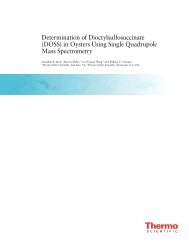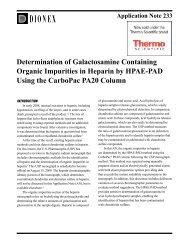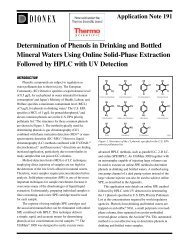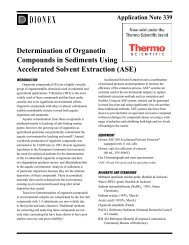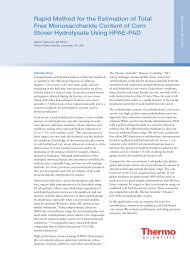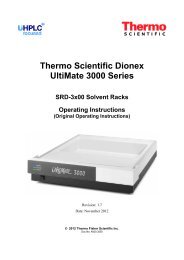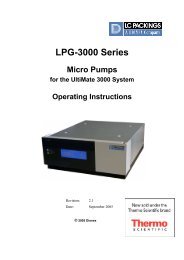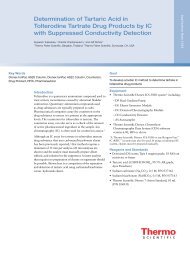Rapid Analysis of Aminothiols by UHPLC with Boron ... - Dionex
Rapid Analysis of Aminothiols by UHPLC with Boron ... - Dionex
Rapid Analysis of Aminothiols by UHPLC with Boron ... - Dionex
Create successful ePaper yourself
Turn your PDF publications into a flip-book with our unique Google optimized e-Paper software.
Thermo Fisher Scientific, 22 Alpha Road, Chelmsford, M<br />
Overview<br />
Purpose: In order to obtain satisfactory information concerning aminothiols,<br />
disulfides, and thioethers from biological samples scientists require a sensitive<br />
approach that can measure key compounds, simultaneously. A simple, accurate<br />
and rapid <strong>UHPLC</strong> method was developed for the analysis <strong>of</strong> these compounds<br />
using isocratic liquid chromatography and an amperometric electrochemical cell<br />
<strong>with</strong> a boron-doped diamond (BDD) working electrode. This allowed the accurate<br />
quantification <strong>of</strong> analytes to low picogram (pg) sensitivity.<br />
Methods<br />
Analytical Conditions for Am<br />
Column:<br />
Pump Flow Rate:<br />
Mobile Phase:<br />
Methods: Direct analysis <strong>of</strong> aminothiols, disulfides and thioethers using <strong>UHPLC</strong><br />
chromatographic techniques <strong>with</strong> a robust electrochemical cell using a BDD<br />
electrode is described.<br />
Results: The method enables the rapid separation <strong>of</strong> various aminothiols,<br />
disulfides, and thioethers at low levels from whole blood <strong>with</strong>out significant matrix<br />
interferences.<br />
Introduction<br />
A number <strong>of</strong> biochemically important sulfur-containing compounds occur in vivo<br />
including: aminothiols (e.g., cysteine, glutathione [GSH], homocysteine), disulfides<br />
(e.g., cystine, glutathione disulfide [GSSG], homocystine), and thioethers (e.g.,<br />
methionine) as shown in Figure 1. These aminothiols plays numerous physiological<br />
roles. GSH is a major cellular antioxidant and a c<strong>of</strong>actor for glutathione peroxidase,<br />
an enzyme that detoxifies hydrogen peroxide and lipid hydroperoxides. The high<br />
ratio <strong>of</strong> GSH/GSSG keeps the cell in a reducing environment, essential for its<br />
survival. Decreases in this ratio are associated <strong>with</strong> cellular toxicity and numerous<br />
diseases including neurodegeneration (e.g., Parkinsonʼs disease). Cysteine is also<br />
a cellular antioxidant, serves as a precursor to glutathione and is <strong>of</strong>ten found in<br />
protein structures as a disulfide link. Methionine is an essential amino acid and<br />
serves as a methyl donor when incorporated into S-adenosylmethionine. Although a<br />
variety <strong>of</strong> HPLC techniques have been developed for the measurement <strong>of</strong> thiols,<br />
disulfides, and thioethers most <strong>of</strong> these exhibit technical issues. UV requires<br />
derivatization which can adversely affect the GSH/GSSG ratio, while some<br />
electrochemical approaches using glassy carbon electrodes suffer from electrode<br />
fouling and loss <strong>of</strong> response, and require routine maintenance. Although porous<br />
graphite working electrodes are more forgiving, they still need maintenance. <strong>Boron</strong>doped<br />
diamond (BDD) however, enable the direct measurement <strong>of</strong> these analytes<br />
<strong>with</strong>out electrode issues. 1,2 The rapid method presented herein is capable <strong>of</strong><br />
accurately determining several aminothiols simultaneously using <strong>UHPLC</strong><br />
chromatographic techniques <strong>with</strong> a BDD working electrode. Examples showing the<br />
analysis <strong>of</strong> GSH and GSSG from plasma samples using a simple “dilute and shoot”<br />
protocol are provided.<br />
Column Temperature:<br />
Post Column Temperature<br />
Injection Volume:<br />
Cell Potential:<br />
Filter Constant:<br />
Cell Clean:<br />
Cell Clean Potential:<br />
Cell Clean Duration:<br />
Sample Prep:<br />
FIGURE 2A. Thermo Scientifi<br />
FIGURE 2B. 6041RS ultra Am<br />
FIGURE 2C. Thermo Scientifi<br />
A<br />
A <strong>UHPLC</strong> approach was chosen as it provides several advantages over standard<br />
HPLC conditions including: shorter cycle times between samples; improved<br />
resolution, and sharper peaks. A sharper peak is important when measuring GSSG<br />
as it occurs at a low concentration and is one <strong>of</strong> the last peaks eluting in biological<br />
samples. The use <strong>of</strong> longer <strong>UHPLC</strong> columns provides better resolution between<br />
compounds, which is important when analyzing biological samples.<br />
FIGURE 1. Molecular structures <strong>of</strong> A) glutathione (GSH), B) glutathione disulfide<br />
(GSSG), C) methionine, and D) homocysteine<br />
A) GSH (reduced form)<br />
B) GSSG (oxidized form)<br />
C) Methionine D) Homocysteine<br />
The Thermo Scientific Di<br />
- SR-3000 Solvent Rack<br />
- DGP-3600RS Dual Gradi<br />
- WPS-3000TBPL Thermos<br />
- ECD-3000RS Electrochem<br />
<strong>with</strong> integrated temperatu<br />
- Chromeleon 6.80 SR12 C<br />
Results and Di<br />
An instrumental prerequisit<br />
inert (free from leachable tr<br />
using an electrochemical de<br />
biocompatible materials in t<br />
contribute to elevated back<br />
introduction <strong>of</strong> the ECD-300<br />
attached in series after the<br />
2 <strong>Rapid</strong> <strong>Analysis</strong> <strong>of</strong> <strong>Aminothiols</strong> <strong>by</strong> <strong>UHPLC</strong> <strong>with</strong> <strong>Boron</strong>-Doped Diamond Electrochemical Detection




